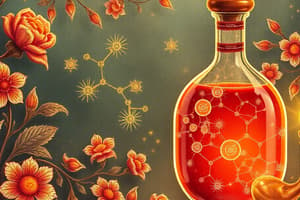Podcast
Questions and Answers
What is the charge of carbocations?
What is the charge of carbocations?
Positively charged
How many bonds do carbanions typically have?
How many bonds do carbanions typically have?
Four bonds
What type of reactions do carbocations participate in?
What type of reactions do carbocations participate in?
S_N1 (substitution nucleophilic unimolecular)
What is the reactivity level of carbocations?
What is the reactivity level of carbocations?
How are carbanions generated?
How are carbanions generated?
What role do carbanions play in reactions?
What role do carbanions play in reactions?
What is the general electronic configuration of carbenes?
What is the general electronic configuration of carbenes?
How are nitrenes described in terms of their electronic structure?
How are nitrenes described in terms of their electronic structure?
What type of reactions are carbenes, nitrenes, and arynes involved in?
What type of reactions are carbenes, nitrenes, and arynes involved in?
How are arynes generated?
How are arynes generated?
What is the key characteristic of aryne, carbene, and nitrene species?
What is the key characteristic of aryne, carbene, and nitrene species?
Describe the [3+2] cycloaddition involving nitrenes.
Describe the [3+2] cycloaddition involving nitrenes.
Flashcards are hidden until you start studying
Study Notes
Reactive Intermediates and Concerted Reactions
In the world of organic chemistry, reactive intermediates play a pivotal role in the reactions that shape molecules into new compounds. These transient species are not often observed in their pure form due to their high reactivity, but they greatly influence the course of chemical transformations. This article will delve into the realm of reactive intermediates, specifically carbocations, carbanions, carbene, nitrene, and arynes, and how they participate in concerted reactions.
Carbocations
Carbocations, also known as carbocation intermediates, are positively charged carbon atoms with three bonds, typically formed by the removal of an alkyl or hydroxyl group from a carbon atom. Carbocations are highly reactive and short-lived due to their positive charge, and they are involved in a wide variety of reactions. They play a key role in S_N1 (substitution nucleophilic unimolecular) reactions, serving as the electrophilic reaction partner for nucleophiles.
Carbanions
Carbanions, or carbide anions, are negatively charged carbon atoms with four bonds. They are generated by the addition of a base to an electrophilic carbon atom, resulting in the breakdown of the carbon-leaving group bond. Carbanions are highly nucleophilic and can undergo a variety of reactions, including nucleophilic substitution, addition reactions, and conjugate addition. Carbanions are involved in S_N2 reactions, serving as the nucleophilic reaction partner for electrophiles.
Carbenes
Carbenes are three-electron, electron-deficient species with a divalent carbon atom bearing two bonds. They can be generated by the homolytic cleavage of a sigma bond, most commonly a carbon-halogen bond or a carbon-carbon triple bond. Carbenes are particularly reactive, and they can insert into a variety of bonds, including C-H, C-C, C-N, and C-O bonds. Carbenes are involved in concerted reactions, such as the [2+2] cycloaddition, which is discussed later in this article.
Nitrenes
Nitrenes are three-electron, electron-deficient species with a divalent nitrogen atom bearing two bonds. They can be generated by the homolytic cleavage of a sigma bond, most commonly a nitrogen-nitrogen triple bond. Nitrenes are highly reactive and can undergo diverse reactions, including insertion into C-H, C-C, C-N, and C-O bonds. Nitrenes are involved in concerted reactions, such as the [3+2] cycloaddition, which is also discussed later in this article.
Arynes
Arynes, or diynes, are three-electron, electron-deficient species with a divalent carbon atom bearing two sigma bonds. They can be generated by the homolytic cleavage of a sigma bond, most often a carbon-carbon triple bond in an aromatic compound. Arynes are highly reactive and can undergo diverse reactions, including insertion into C-H, C-C, C-N, and C-O bonds. Arynes are involved in concerted reactions, such as the [2+2] cycloaddition.
Concerted Reactions
Concerted reactions are single-step processes in which two or more bonds form or break simultaneously, resulting in the formation of a single product. In contrast, stepwise reactions involve multiple, separate steps to achieve the same outcome. Concerted reactions are favored over stepwise alternatives when the transition states involved have lower energy barriers, reducing the activation energy required for the reaction to occur.
Carbenes and nitrenes are particularly important in concerted reactions, as they can undergo [2+2] or [3+2] cycloadditions. In the [2+2] cycloaddition, a divalent carbon species reacts with a two-electron system, such as a double bond, to form a cyclobutane ring. In the [3+2] cycloaddition, a divalent nitrogen species reacts with a three-electron system, such as an alkene and an alkene or an alkyne, to form a cyclic amine or an aziridine ring, respectively.
Concerted reactions are essential in synthesis and have numerous applications, such as the Diels-Alder reaction, which is a [4+2] cycloaddition involving a diene and a dienophile to form cyclohexene derivatives with high stereoselectivity. The [2+2] and [3+2] cycloadditions, involving carbene and nitrene species, also have important applications, such as the synthesis of heterocycles and the formation of carbon-nitrogen bonds.
In summary, reactive intermediates, such as carbocations, carbanions, carbene, nitrene, and arynes, play a significant role in organic chemistry. They are involved in various reactions and concerted processes, such as the Diels-Alder reaction, [2+2] and [3+2] cycloadditions, and S_N1 and S_N2 reactions. These intermediates are essential in synthesis and have a wide range of applications in the field of organic chemistry.
Studying That Suits You
Use AI to generate personalized quizzes and flashcards to suit your learning preferences.




